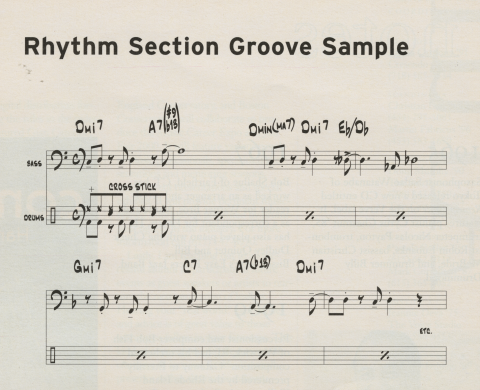Using Inspiration and Writing Tools

In writing my piece "Tiara" I relied on inspiration as well as the music writing tools that I have learned to use over the years. Writing spontaneously is fun and sometimes brings great results, but having a strong melodic and harmonic vocabulary gives a composer greater choices and contributes to consistent writing.
The A section of "Tiara" came to me pretty easily. The opening melody was conceived on soprano saxophone. I wrote it down and then harmonized it. The melody and most of the chords are diatonic to the key of d minor. The bridge, or B section, required a little more thought. I wrote it at the piano. Playing the melody and chords of the A section led me to a concept for the bridge. Gradually, I left the key of d minor in this section and made the melody peak where the key relationships were changing. This happens in the last three bars of the B section before the tonality of d minor comes back in the C section. At letter C, I returned to the melodic and harmonic material of A section to round the tune's AABA form. I wrote the melody an octave higher this time to continue to build the climax.
The melody mostly centers around the d natural minor scale for the A sections. In the first bar of the bridge, the melody utilizes the same rhythm as the first bar of the A section, but begins on a different pitch and moves through several temporary keys until the last bar where a V chord leads back to d minor.
I use a combination of melodic and harmonic approaches when I solo on the tune. I switch back and forth from concentrating on the key center in the A sections to playing on the changes at the bridge. The first three bars are basically d natural minor (with the exception of the d minor/major 7 in bar three and the Eb/Db in bar 4). I usually bring out the colors of the hybrid chords by playing on the notes of the upper structures. Consequently, I almost never play on chord scales in the bridge section. Since I wrote the tune, my ears naturally want to stay true to the original intent of the melody and harmony. Consequently, my improvisation reflects the flavor of the tune. Of course, anyone else playing on it may discover many other possibilities.
In developing this tune for the record, we made some interesting production decisions. Keyboardist/producer Alain Mallet and I were working on a demo for the record company, when we discovered a drum loop sample on a record that had a scratch in it. It worked so well with the bossa-type groove of the tune that we used it. The keyboard, bass, percussion, and keyboard solo were performed by Mallet, and I played soprano saxophone. He used a Mini-Moog bass patch, layered electric piano sounds, and added strings to the bridge. Ultimately, the demo sounded so complete, that when it came time to rerecord the tune for the CD, I decided not to change it. The old saying, "If it ain't broke don't fix it" came to mind.

Dan Moretti is an associate professor in the Contemporary Writing Department. "Tiara" was released nationally on Moretti's CD That's Right on the 1201 music label. The song is available for downloading at <www.danmoretti.com>.





